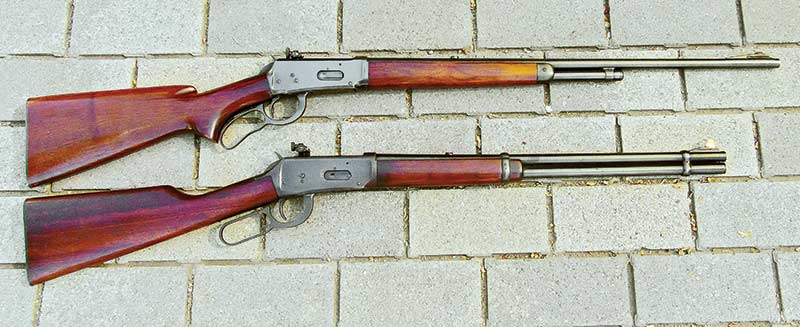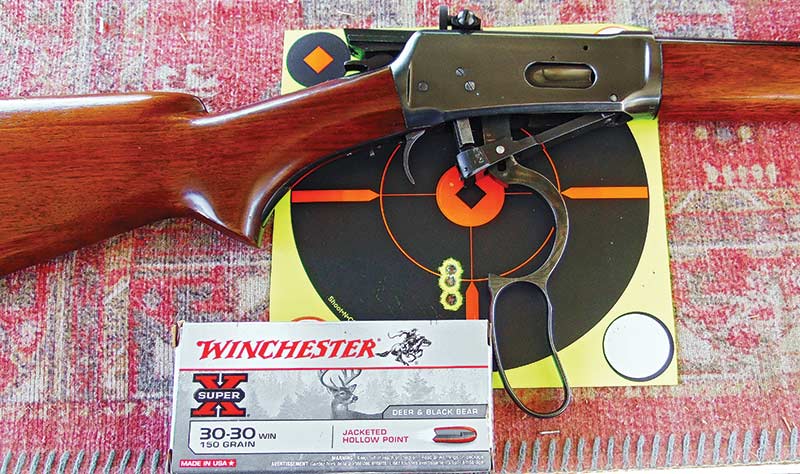Refined lever is a classic “class act”

A late 1940s-vintage Model 64 (top) features a 24″ barrel, pistol grip and two-thirds magazine. The early 1960s Model 94 (below) features a 20″ barrel, straight grip and full-length magazine.
A whole lot of lovers of leverguns consider Winchester’s graceful Model 64 to be the best-looking rifle ever put together — and they’ll certainly get no argument from me.
If any make or model of lever action better fits the definition of “deer rifle,” I don’t know what it could be. In fact, a deluxe version was, at one time, marketed as “The Deer Rifle.”
As an 11-year-old rifle-crazy kid, I can still remember thinking the full-page picture of the Model 64 in my early ’50s copy of Stoeger’s Shooter’s Bible was just about the coolest thing ever.
In the years after, I got to use — and own — various straight-gripped 20″ Model 94 Carbines and 16″ Trapper models, but still the 24″ barrel M64 with its two-thirds length magazine and pistol grip haunted me.
The Lyman 66A receiver sight is a serious improvement over the original buckhorn open sights.
This 2011 Miroku-made Model 64 is an Angle Eject design and is drilled and tapped for scope mounts. The tang safety is easier to access than the later crossbolt safety installed after 1992.
History
Officially introduced in 1933 as a refined replacement for the Model 55 — another Model 94 variant — the Model 64 ceased production in 1957. Early on, it could be had in .25-35 and .32 Winchester Special. There were a very few made in .219 Zipper with a 26″ barrel, but the majority of them were in .30-30.
It was briefly reintroduced by Winchester in 1972 and again as a Miroku-made offering in 2011.
The Japanese-made Miroku Model 64 is different from the original Winchester in two major respects. First off, it’s an Angle Eject and is drilled and tapped for optic mounts, giving you a far easier scoping option than the original if this is your preference.
Secondly, it features a tang safety, not always beloved by purists but a darn sight preferable — and more accessible — than the crossbolt safety in a dished-out receiver recess Winchesters were saddled with in 1992.
The only drawback to the tang safety placement is it makes the installation of a folding tang peep sight out of the question.

Range Time
So let’s get crass and talk ballistics and address the burning question: Besides sheer aesthetics, what’s the extra barrel going to get you over the vastly more popular Model 94 Carbine?
The velocity pickup from the Model 64’s 24″ barrel over a 20″ Model 94 is fairly significant although not really breathtaking when you take the .30-30’s practical sphere of usefulness into consideration.
Here are the numbers we got: Hornady 140-grain Full Boar — 2,607 fps vs. 2,442 fps, Hornady 160-grain LEVERevolution Flex Tip — 2,571 fps vs. 2,280 fps and Winchester 150-grain JHP — 2,441 fps vs. 2,283 fps.
Although the speed bump from the Model 64’s 24″ tube doesn’t quite turn the .30-30 into a .308, at real-world deer yardages, it’s close enough.
Our test gun was a late 1940s specimen in breathtaking shape. The owner, John Wightman, made the intelligent decision of installing a Lyman 66 receiver sight on it rather than rely on the original-issue buckhorn open sights — which aren’t all that wonderful in conjunction with elderly eyes.
Our Model 64 preferred Winchester’s traditional 150-grain JHP a
bit more than Hornady’s polymer tipped 160-grain LEVERevolution.
Slight Adjustments
Moving up the barrel and yanking the blasted sight hood off, we found the original bead front to be fairly small. Yes, a larger bead would be quicker and easier to acquire, but then you’d have to deal with the fact a “too big” bead will practically subtend an 8″ bull at 50 yards.
If you have to form a “figure 8” using a 6 o’clock hold, a smaller bead works better. Of course, a flat-top blade would be the best choice — which is something to consider if your goal is to enhance the “on paper” performance of your rifle. “Flat on round” works better than “round on round” for me, particularly since my eyes ain’t what they used to be.
For field use, many shooters simply remove the aperture from the Lyman sight, giving you a large, quick-to-acquire facsimile of a “ghost ring.”
From a sandbag rest at 60 yards, our Model 64 showed a distinct preference for traditional 150-grain ammo, specifically Winchester Super-X JHPs. Runner-up in the accuracy department was Hornady 160-grain FTX LEVERevolution.
We did our preliminary sight adjustments at 25 yards using 150-grain handloads, both to get acquainted with the rifle and to help hoard our factory stuff for later. Centerfire metallic ammo in non-NATO calibers isn’t easy to find these days!
The trigger on our test gun exhibited a bit of takeup and broke at a few ounces under 4 lbs., pretty good for a dead-stock levergun of any era. Recoil was noticeably tamer than from the lighter (by about a half-pound), shorter Model 94 Carbine we had along for the ride.
Both featured recoil padless shotgun-style buttplates, but I’m pretty certain the Model 64 would have been quite tolerable even if it had been saddled with an older crescent-style buttplate.
According to Steve Fjestad’s Blue Book of Gun Values, 66,783 Model 64s were produced in the original 1933–1957 run, while 8,250 were made in the 1972–73 cycle, all in .30-30 and referred to as the Model 64A.
Obviously, these numbers are dwarfed by those of the Model 94, so prices of the Model 64 in used racks and auctions are going to reflect this discrepancy. Thus, if you’re hot for one you find, you may have to dig deep.